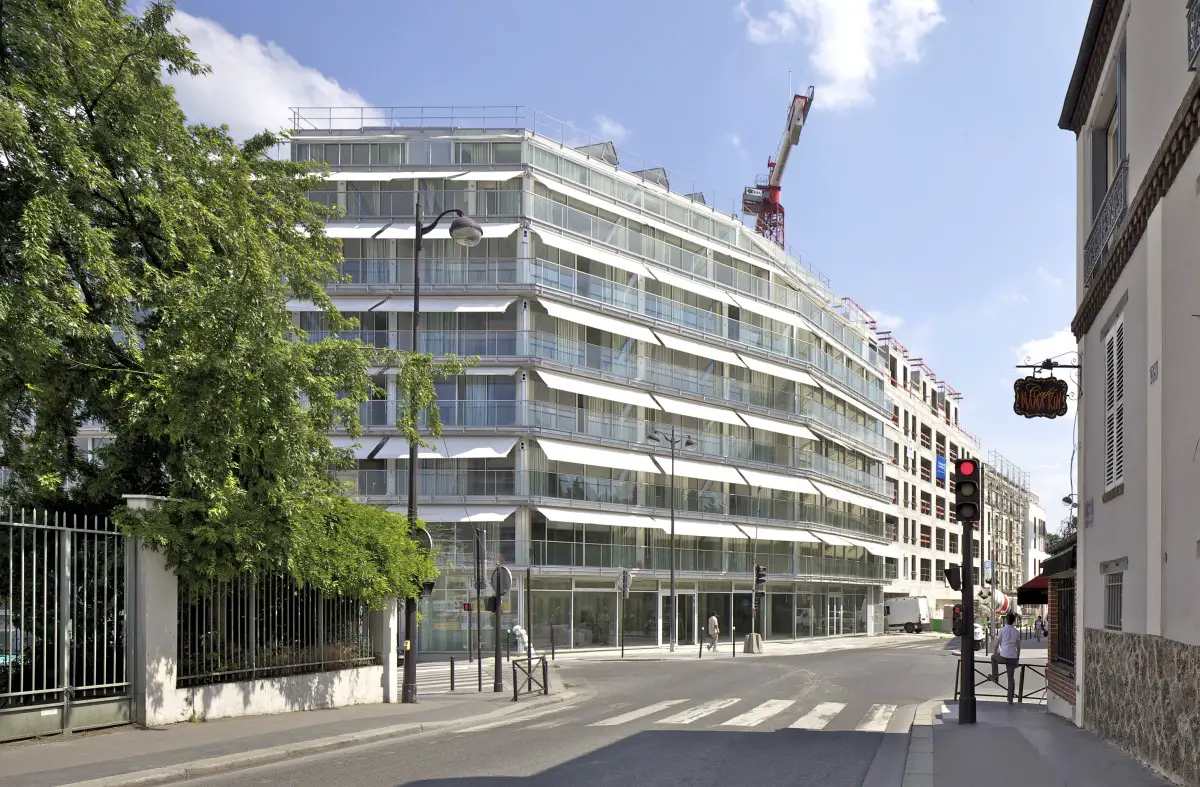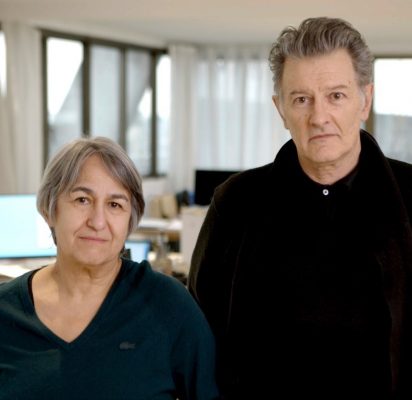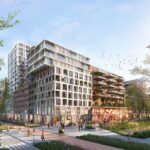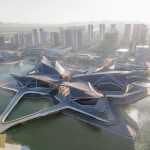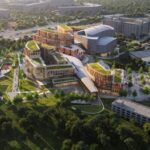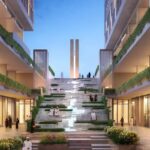Lacaton + Vassal Architects, French Design Office, Pritzker Architecture Prize, Building Projects Photos
Lacaton + Vassal Paris Architecture
Parisian Architecture Practice based in Le Fournil de Paris, France: Prize News
post updated 14 May 2021
Anne Lacaton and Jean-Philippe Vassal News
Anne Lacaton, Professor Emeritus of Architecture and Design at ETH Zurich, and her partner Jean-Philippe Vassal have been awarded this year’s Pritzker Prize for their sustainable and social approach to building design. To celebrate this exceptional achievement, ETH Zurich is hosting a virtual roundtable.
The event details:
Tribute to and with Anne Lacaton and Jean-Philippe Vassal
Wednesday, 19 May 2021
12.00–13:00
LiveStream: https://vimeo.com/event/685706/c79bbce8e3
Mar 17 & 16, 2021
Pritzker Architecture Prize 2021 Announcement
Anne Lacaton and Jean-Philippe Vassal Win 2021 Pritzker Architecture Prize
Anne Lacaton and Jean-Philippe Vassal, of France, have been selected as the 2021 Pritzker Architecture Prize Laureates, announced Tom Pritzker, Chairman of The Hyatt Foundation, which sponsors the award that is known internationally as architecture’s highest honor.
Anne Lacaton and Jean-Philippe Vassal
Latapie House, Floirac, France, 1993:
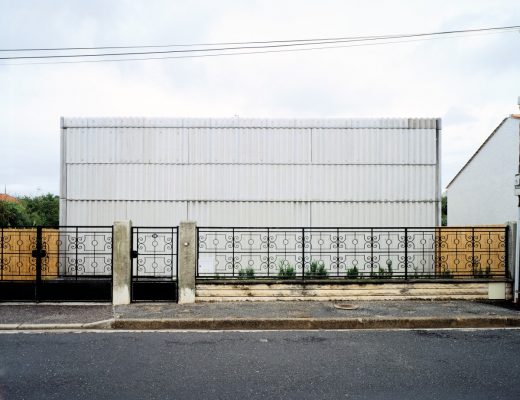
photo courtesy of Philippe Ruault
Announcing the 2021 Laureates
Anne Lacaton and Jean-Philippe Vassal Receive the 2021 Pritzker Architecture Prize
Chicago, IL (March 16, 2021) – Anne Lacaton and Jean-Philippe Vassal, of France, have been selected as the 2021 Pritzker Architecture Prize Laureates, announced Tom Pritzker, Chairman of The Hyatt Foundation, which sponsors the award that is known internationally as architecture’s highest honor.
“Good architecture is open—open to life, open to enhance the freedom of anyone, where anyone can do what they need to do,” says Lacaton. “It should not be demonstrative or imposing, but it must be something familiar, useful and beautiful, with the ability to quietly support the life that will take place within it.”
Through their design of private and social housing, cultural and academic institutions, public spaces, and urban developments, Lacaton and Vassal reexamine sustainability in their reverence for preexisting structures, conceiving projects by first taking inventory of what already exists. By prioritizing the enrichment of human life through a lens of generosity and freedom of use, they are able to benefit the individual socially, ecologically and economically, aiding the evolution of a city.
“Not only have they defined an architectural approach that renews the legacy of modernism, but they have also proposed an adjusted definition of the very profession of architecture. The modernist hopes and dreams to improve the lives of many are reinvigorated through their work that responds to the climatic and ecological emergencies of our time, as well as social urgencies, particularly in the realm of urban housing. They accomplish this through a powerful sense of space and materials that creates architecture as strong in its forms as in its convictions, as transparent in its aesthetic as in its ethics,” states the 2021 Jury Citation, in part.
129 Units, Ourcq-Juarès Student and Social Housing, France:
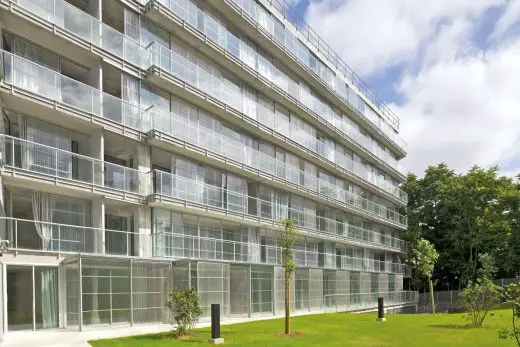
photo courtesy of Philippe Ruault
The architects increase living space exponentially and inexpensively, through winter gardens and balconies that enable inhabitants to conserve energy and access nature during all seasons. Latapie House (Floirac, France 1993) was their initial application of greenhouse technologies to install a winter garden that allowed a larger residence for a modest budget. The east-facing retractable and transparent polycarbonate panels on the back side of the home allow natural light to illuminate the entire dwelling, enlarging its indoor communal spaces from the living room to the kitchen, and enabling ease of climate control.
“This year, more than ever, we have felt that we are part of humankind as a whole. Be it for health, political or social reasons, there is a need to build a sense of collectiveness. Like in any interconnected system, being fair to the environment, being fair to humanity, is being fair to the next generation,” comments Alejandro Aravena, Chair of the Pritzker Architecture Prize Jury. “Lacaton and Vassal are radical in their delicacy and bold through their subtleness, balancing a respectful yet straightforward approach to the built environment.”
On a grander scale, Lacaton and Vassal, alongside Frédéric Druot, transformed La Tour Bois le Prêtre (Paris, France 2011), a 17-story, 96-unit city housing project originally built in the early 1960s. The architects increased the interior square footage of every unit through the removal of the original concrete façade, and extended the footprint of the building to form bioclimatic balconies. Once constrained living rooms now extend into new terraces as flexible space, featuring large windows for unrestricted views of the city, thus reimagining not only the aesthetic of social housing, but also the intention and possibilities of such communities within the urban geography.
This framework was similarly applied to the transformation of three buildings (G, H and I), consisting of 530 apartments, at Grand Parc (Bordeaux, France 2017), with Druot and Christophe Hutin. The transformation resulted in a dramatic visual reinvention of the social housing complex, the modernization of elevators and plumbing, and the generous expansion of all units, some nearly doubling in size, without the displacement of any residents and for one third of the cost of demolishing and building new.
“Our work is about solving constraints and problems, and finding spaces that can create uses, emotions and feelings. At the end of this process and all of this effort, there must be lightness and simplicity, when all that has been before was so complex,” explains Vassal.
The architects rebalance dormant or inefficient rooms to yield open spaces that accommodate greater movement and changing needs, thus lengthening the longevity of the buildings. Their most recent transformation of Palais de Tokyo (Paris, France 2012), after a restoration of the space more than a decade earlier, increased the museum by 20,000 square meters, in part by creating new underground space, and assuring that every area of the building is reserved for the user experience.
Retreating from white cube galleries and guided pathways that are characteristic of many contemporary art museums, the architects instead created voluminous, unfinished spaces. These spaces allow artists and curators to create boundless exhibitions for all mediums of art within a range of physical environments, from dark and cavernous to transparent and sunlit, that encourage visitors to linger. Lacaton insists, “Transformation is the opportunity of doing more and better with what is already existing. The demolishing is a decision of easiness and short term. It is a waste of many things—a waste of energy, a waste of material, and a waste of history. Moreover, it has a very negative social impact. For us, it is an act of violence.”
Adhering to a precept of “never demolish”, Lacaton and Vassal undertake restrained interventions to upgrade dated infrastructure while allowing enduring properties of a building to remain.
Rather than filling and losing the impressive void of the Atelier de Préfabrication no. 2 (AP2), a postwar shipbuilding facility at the shoreline of a waterfront redevelopment project, the architects chose to erect a second building, identical in shape and size to the first. They used transparent, prefabricated materials, resulting in unhindered views through the new to the old. The original landmark, designated for public programming, and the newer structure, FRAC Nord-Pas de Calais (Dunkerque, France 2013), housing galleries, offices and storage for the regional collections of contemporary art, can function independently or collaboratively. They are connected by an internal street located in the void between the two structures.
Much of their work encompasses new buildings, and the École Nationale Supérieure d’Architecture de Nantes (Nantes, France 2009) exemplifies the significance of freedom of use. To accommodate the range of pedagogies necessary for its growing student body, the plot was maximized and the architects were able to almost double the space outlined in the brief and do so within budget.
Located at the bank of the Loire River, this large-scale, double-height, three-story building features a concrete and steel frame encased in retractable polycarbonate walls and sliding doors. Areas of various sizes exist throughout, and all spaces are deliberately unprescribed and adaptable. An auditorium can open to extend into the street, and high ceilings create generous spaces necessary for construction workshops. Even the wide, sloping ramp that connects the ground to the 2,000 square meter functional rooftop is intended as a flexible learning and gathering space.
“Anne Lacaton and Jean-Philippe Vassal have always understood that architecture lends its capacity to build a community for all of society,” remarks Pritzker. “Their aim to serve human life through their work, demonstration of strength in modesty, and cultivation of a dialogue between old and new, broadens the field of architecture.”
Significant works also include Cap Ferret House (Cap Ferret, France 1998), 14 social houses for Cité Manifeste (Mulhouse, France 2005); Pôle Universitaire de Sciences de Gestion (Bordeaux, France 2008); low-rise apartments for 53 units (Saint-Nazaire, France 2011), a multipurpose theater (Lille, 2013), Ourcq-Jaurès student and social housing (Paris, France 2013); a 59-unit social housing development at Jardins Neppert (Mulhouse, France 2014–2015); and a residential and office building in Chêne-Bourg (Geneva, Switzerland 2020).
They established their practice, Lacaton & Vassal, in Paris in 1987, and have completed over 30 projects throughout Europe and West Africa. Lacaton and Vassal are the 49th and 50th Laureates of the Pritzker Architecture Prize.
About the Pritzker Architecture Prize
The Pritzker Architecture Prize was founded in 1979 by the late Jay A. Pritzker and his wife, Cindy. Its purpose is to honor annually a living architect or architects whose built work demonstrates a combination of those qualities of talent, vision and commitment, which has produced consistent and significant contributions to humanity and the built environment through the art of architecture.
Jury Citation
The work of Anne Lacaton and Jean-Philippe Vassal reflects architecture’s democratic spirit. Through their ideas, approach to the profession, and the resulting buildings, they have proven that a commitment to a restorative architecture that is at once technological, innovative, and ecologically responsive can be pursued without nostalgia. This is the mantra of the team of Anne Lacaton and Jean-Philippe Vassal since founding their Paris-based firm in 1987.
Not only have they defined an architectural approach that renews the legacy of modernism, but they have also proposed an adjusted definition of the very profession of architecture. The modernist hopes and dreams to improve the lives of many are reinvigorated through their work that responds to the climatic and ecological emergencies of our time, as well as social urgencies, particularly in the realm of urban housing. They accomplish this through a powerful sense of space and materials that creates architecture as strong in its forms as in its convictions, as transparent in its aesthetic as in its ethics. At once beautiful and pragmatic, they refuse any opposition between architectural quality, environmental responsibility, and the quest for an ethical society.
For more than 30 years, their critical approach to architecture has embodied generosity of space, ideas, uses and economy of means, materials, and also of shape and form. This approach has resulted in innovative projects for residential, cultural, educational, and commercial buildings. Since their early projects, including Latapie House, the private house in Bordeaux, and civic works such as the proposal for the Human Science Center in Saint-Denis or the School of Architecture in Nantes, they have shown sensitivity and warmth of experience to their buildings’ users. The architects have expressed that buildings are beautiful when people feel well in them, when the light inside is beautiful and the air is pleasant, and when there is an easy flow between the interior and exterior.
The notion of belonging and being accountable to a larger whole involves not only fellow humans but the planet in general. From very early on, Anne Lacaton and Jean-Philippe Vassal have consistently expanded the notion of sustainability to be understood as a real balance between its economic, environmental and social pillars. Their work has delivered through a variety of projects that actively address responsibility in these three dimensions.
The practice begins every project with a process of discovery which includes intensely observing and finding value in what already exists. In the case of the 1996 commission, Léon Aucoc Plaza, their approach was simply to undertake the minimal work of replacing the gravel, treating the lime trees, and slightly modifying the traffic, all to grant renewed potential to what already existed.
In their housing projects for the transformation of the Paris block, Tour Bois le Prêtre, and three blocks in the Grand Parc neighborhood in Bordeaux (both realized with Frédéric Druot), instead of demolition and reconstruction they carefully added space to the existing buildings in the form of generous extensions, winter gardens and balconies that allow for freedom of use and therefore are supportive of the real lives of the residents. There is a humility in the approach that respects the aims of the original designers and the aspirations of the current occupants.
For the cultural center, FRAC Nord-Pas de Calais in Dunkirk, they chose to keep the original hall and attach a second one of similar dimensions to the existing building. Absent is nostalgia for the past. Rather, they seek transparency, openness, and luminosity with a respect for the inherited and a quest to act responsibly in the present. Today, a building that previously went unnoticed becomes an iconic element in a renewed cultural and natural landscape.
Through their belief that architecture is more than just buildings, through the issues they address and the proposals they realize, through forging a responsible and sometimes solitary path illustrating that the best architecture can be humble and is always thoughtful, respectful, and responsible, they have shown that architecture can have a great impact on our communities and contribute to the awareness that we are not alone. For their body of work realized and that of the future, Anne Lacaton and JeanPhilippe Vassal are named the 2021 Pritzker Prize Laureates.
Jury Members
– Alejandro Aravena (Chair)
Architect, Educator and 2016 Pritzker Laureate
Santiago, Chile
– Barry Bergdoll
Architecture Historian, Educator, Curator and Author
New York, New York
– Deborah Berke
Architect and Dean, Yale School of Architecture
New York, New York
– Stephen Breyer
U.S. Supreme Court Justice
Washington, DC
– André Aranha Corrêa do Lago
Architectural Critic, Curator and Brazilian Ambassador to India
Delhi, India
– Kazuyo Sejima
Architect and 2010 Pritzker Laureate
Tokyo, Japan
– Wang Shu
Architect, Educator and 2012 Pritzker Laureate
Hangzhou, China
– Benedetta Tagliabue
Architect and Educator
Barcelona, Spain
– Martha Thorne (Executive Director)
Dean, IE School of Architecture & Design
Madrid, Spain
– Manuela Lucá-Dazio (Advisor)
Paris, France
Biography
Anne Lacaton (1955, Saint-Pardoux, France) and Jean-Philippe Vassal (1954, Casablanca, Morocco)
met in the late 1970s during their formal architecture training at École Nationale Supérieure
d’Architecture et de Paysage de Bordeaux. Lacaton went on to pursue a Masters in Urban Planning
from Bordeaux Montaigne University (1984), while Vassal relocated to Niger, West Africa to practice
urban planning. Lacaton often visited Vassal, and it was there that the genesis of their architectural
doctrine began, as they were profoundly influenced by the beauty and humility of sparing resources
within the country’s desert landscapes.
“Niger is one of the poorest countries in the world, and the people are so incredible, so generous,
doing nearly everything with nothing, finding resources all the time, but with optimism, full of poetry
and inventiveness. It was really a second school of architecture,” recalls Vassal.
In Niamey, Niger, Lacaton and Vassal built their first joint project, a straw hut, constructed with
locally sourced bush branches, which yielded surprising impermanence, relenting to the wind within
two years of completion. They vowed to never demolish what could be redeemed and instead,
make sustainable what already exists, thereby extending through addition, respecting the luxury of
simplicity, and proposing new possibilities.
They established Lacaton & Vassal in Paris (1987), and have since demonstrated boldness through
their design of new buildings and transformative projects. For over three decades, they have designed
private and social housing, cultural and academic institutions, public space, and urban strategies.
The duo’s architecture reflects their advocacy of social justice and sustainability, by prioritizing a
generosity of space and freedom of use through economical and ecological materials.
Providing physical and emotional wellbeing has also been intentional in their work. Their application of
greenhouse technologies to create bioclimatic conditions began with Latapie House in Floirac, France
(1993). Using the sun, in harmony with natural ventilation, solar shading and insulation, they created
adjustable and desirable microclimates. “From very early on, we studied the greenhouses of botanic
gardens with their impressive fragile plants, the beautiful light and transparency, and ability to simply
transform the outdoor climate. It’s an atmosphere and a feeling, and we were interested in bringing
that delicacy to architecture,” shares Lacaton.
Through both new construction and the transformation of buildings, honoring the pre-existing is
authentic to their work. A private residence in Cap Ferret, France (1998) was built on an undeveloped
plot along Arcachon Bay, with the goal of minimal disruption to the natural environment. Rather than
fell the 46 trees on the site, the architects nurtured the native vegetation, elevating the home and
constructing around the trunks that intersected it, allowing occupants to live among the plant life.
Lacaton explains, “the pre-existing has value if you take the time and effort to look at it carefully. In
fact, it’s a question of observation, of approaching a place with fresh eyes, attention and precision…
to understand the values and the lacks, and to see how we can change the situation while keeping all
the values of what is already there.”
Their skillful selection of modest materials enables the architects to build larger living spaces
affordably, as demonstrated by the construction of 14 single-family residences for a social housing
development (2005), and 59 units within low-rise apartment buildings at Neppert Gardens (2015),
both in Mulhouse, France; and in adjoining mid-rise buildings consisting of 96 units in Chalon-surSaône, France (2016); among others.
Throughout their careers, the architects have rejected city plans calling for the demolition of social
housing, focusing instead on designing from the inside out to prioritize the welfare of a building’s
inhabitants and their unanimous desires for larger spaces. Alongside Frédéric Druot and Christophe
Hutin, they transformed 530 units within three buildings at Grand Parc in Bordeaux, France (2017) to
upgrade technical functions but more notably, to add generous flexible spaces to each unit without
displacing its residents during construction, and while maintaining rent stability for the occupants.
“We never see the existing as a problem. We look with positive eyes because there is an opportunity
of doing more with what we already have,” states Lacaton. “We went to places where buildings
would have been demolished and we met people, families who were attached to their housing, even
if the situation was not the best. They were most often opposed to the demolition because they
wished to stay in their neighborhood. It’s a question of kindness,” continues Vassal.
Current works in progress include the housing transformations of a former hospital into a 138-unit,
mid-rise apartment building in Paris, France, and an 80-unit, mid-rise building in Anderlecht,
Belgium; the transformation of an office building in Paris, France; mixed-use buildings offering hotel
and commercial space in Toulouse, France; and a 40-unit, private housing, mid-rise building in
Hamburg, Germany.
“Good architecture is a space where something special happens, where you want to smile, just
because you are there,” shares Vassal. “It is also a relationship with the city, a relationship with what
you see, and a place where you are happy, where people feel well and comfortable—a space that
gives emotions and pleasures.”
Lacaton is an associate professor of Architecture and Design at the Swiss Federal Institute of
Technology ETH Zurich (Zurich, Switzerland, since 2017), and a visiting professor at Polytechnic
University of Madrid, Master in Housing (Madrid, Spain, since 2007). She has been a visiting professor
at Delft University of Technology (Delft, Netherlands, 2016–2017) and Technische Hochschule
Nürnberg Georg Simon Ohm (Nürnberg, Germany, 2014); was the Design Critic in Architecture (2015)
and the Kenzo Tange Visiting Chair in Architecture and Urban Planning (2011) at Harvard Graduate
School of Design (Cambridge, MA); and the Clarkson Chair at the University of Buffalo (Buffalo, NY,
2013). She served on the LafargeHolcim Awards jury for Europe (2017) and will be a member of
the 2021 jury later this year.
Vassal is an associate professor at Universität der Künste Berlin (Berlin, Germany since 2012) and
has previously taught at Technische Universität Berlin (Berlin, Germany, 2007–10); Peter Behrens
School of Arts at the University of Applied Sciences (Dusseldorf, Germany, 2005); École Nationale
Supérieure d’Architecture de Versailles (Versailles, France, 2002–2006); and École Nationale
Supérieure d’Architecture et de Paysage de Bordeaux (1992–99). He was head of the jury for
LafargeHolcim Awards, Europe (2014) and a juror (2008 & 2011).
Together, they have held visiting professorships at Sassari University in Alghero (Alghero, Italy,
2014–2015); the Pavilion Neuize OBC-Palais de Tokyo (Paris, France, 2013–14); and the Swiss Federal
Institute of Technology (Lausanne, Switzerland, 2010–11). Lacaton and Vassal are the recipients
of the BDA Grand Prize, 2020; Global Award for Sustainable Architecture, Cité de l’Architecture & du
Patrimoine, 2018, with Druot; Académie d’Architecture, Gold Medal, 2016; the Heinrich Tessenow
Medal, 2016; the Rolf Schock Prize, Visual Arts, 2014; Daylight & Building Components Award,
Villum Foundation and Velux Foundation, 2011; the International Fellowship from the Royal Institute
of British Architects, 2009; the Grand Prix National d’Architecture, France, 2008; and the Schelling
Architecture Award, 2006.
Their practice, Lacaton & Vassal, has been awarded the Lifetime Achievement Award, Trienal
de Lisboa (2016); and the Fundació Mies van der Rohe, European Union Prize for Contemporary
Architecture (2019) along with Frédéric Druot Architecture and Christophe Hutin Architecture for
the transformation of 530 Dwellings at Grand Parc, Bordeaux.
Joint publications include freespace (Anne Lacaton & Jean-Philippe Vassal, on the occasion of the
16th International Architecture Exhibition, La Biennale di Venezia, 2018), The Incidents. Freedom
of Use (Harvard University Graduate School of Design, Sternberg Press, 2015), PLUS: Large Scale
Housing Development. An Exceptional Case with Druot (Editorial Gustavo Gili, SL, 2007), and Il fera
beau demain (Anne Lacaton & Jean Philippe Vassal, Institut Français d’Architecture, 1995).
They work and reside in Paris, France.
BUILT WORKS
2021 18 Units, Low-Rise Apartments, Social Housing, Rixheim, France
2020 Residential and Office Building, Chêne-Bourg, Geneva, Switzerland
2019 Hotel Lacoste Dakar (opening pending completion of interiors), Dakar, Senegal
2017 Transformation of G, H, I Buildings, Grand Parc, 530 Units, Social Housing (with Frédéric Druot
and Christophe Hutin), Bordeaux, France
2016 96 Units, Mid-Rise Apartments, Social Housing, Chalon-sur-Saône, France
Transformation of 40 Units, Mid-Rise Apartments, Phase 2, Social Housing,
Saint-Nazaire, France
2014– 59 Units, Low-Rise Apartments, Jardins Neppert, Social Housing, Mulhouse, France
2015
2014 Addition of 40 Units, Mid-Rise Apartments, Phase 1, Social Housing, Saint-Nazaire, France
2013 129 Units, Ourcq-Jaurès Student and Social Housing, Paris, France
FRAC Nord-Pas de Calais, Dunkerque, France
Multipurpose Theater, Lille, France
2012 50,000 Units, Urban Planning, Bordeaux, France
Site for Contemporary Creation, Phase 2, Palais de Tokyo, Paris, France
2011 53 Units, Low-Rise Apartments, Social Housing, Saint-Nazaire, France
Transformation of 100 Units, Tour Bois le Prêtre (with Frédéric Druot), Social Housing, Paris, France
2010 23 Units, Low-Rise Apartments, Social Housing, Trignac, Saint-Nazaire, France
2009 École Nationale Supérieure d’Architecture de Nantes, Nantes, France
2008 Pôle Universitaire de Sciences de Gestion, Bordeaux, France
2007 Aue Pavilion, Documenta 12, Kassel, Germany
Exhibition Hall, Paris Nord Villepinte, France
Wine Cellars, Embres-et-Castelmaure, France
2005 14 Residences, Social Housing, Mulhouse, France
Keremma House, Tréflez, France
2002 Office Building, Nantes, France
Site for Contemporary Creation, Phase 1, Palais de Tokyo, Paris, France
2001 Arts and Human Sciences Building, Pierre Mendès-France University, Grenoble, France
Café Restaurant Corbaci, Architekturzentrum Wein, Vienna, Austria
2000 House in Coutras, Coutras, France
1999 House in Bordeaux, Bordeaux, France
1998 House in Cap Ferret, Cap Ferret, France
1997 House in Dordogne, Dordogne, France
1996 Place Léon Aucoc, Bordeaux, France
1994 Therapy Center for Adolescents, Bègles, France
1993 Latapie House, Floirac, France
1984 Straw Hut, Niamey, Niger
WORKS IN PROGRESS
138 Units, Mid-Rise Apartments, Transformation and Addition of Hospital Saint-Vincent-De-Paul to Housing, Paris, France
40 Units, Housing, Hamburg, Germany
Mixed-Use, Mid-Rise Buildings: Hotels, Offices, Commercial, Toulouse, France
Transformation of a Mid-Rise Office Building, Paris, France
Transformation of Tour Peterbos, 80 Units, Mid-Rise Apartments, Social Housing (with 51N4E), Anderlecht, Belgium
EXHIBITIONS
2020 Living the City, Airport Berlin Tempelhof, Berlin, Germany
urbainable – stadthaltig. Positions on the European City in the 21st Century, Akademie der Künste, Berlin, Germany
2019– Constructing the escape, FRAC Centre, Orléans, France
2020
2019 What’s old, What’s new (Exhibition EU Mies Award 2019), Mies van der Rohe Pavilion, Barcelona, Spain
2018 Freedom of use, La Biennale di Venezia, Venice, Italy
inhabiting: pleasure and luxury for everyone, aut. architektur und tirol, Innsbruck, Austria
2015– The Imaginaries of Transformation (film with Frédéric Druot), Chicago Architectural Biennial, Chicago, IL, USA
2010– Small Scale, Big Change: New Architectures of Social Engagement, Museum of Modern Art, New York, NY
AWARDS
2020 BDA Grand Prize, Bund Deutscher Architektinnen, Germany
2019 Fundació Mies Van der Rohe Award, European Union Prize for Contemporary Architecture (with Frédéric Druot Architecture and Christophe Hutin Architecture for the transformation of
530 dwellings at Grand Parc, Bordeaux), Spain
2018 Global Award for Sustainable Architecture, Cité de l’Architecture & du Patrimoine (with Frédéric Druot), France
2016 Académie d’Architecture Gold Medal, France
Heinrich Tessenow Gold Medal, Foundation Heinrich Tessenow, Germany
Lifetime Achievement Award, Trienal de Lisboa (awarded to Lacaton & Vassal), Portugal
2014 Rolf Schock Prize, Visual Arts, Sweden
2011 Daylight & Building Components Award, Villum Foundation and Velux Foundation, Denmark
2008 Grand Prix National d’Architecture, France
2006 Schelling Architecture Award, Schelling Architecture Foundation, Germany
SELECTED BIBLIOGRAPHY
Publications written by Anne Lacaton and Jean-Philippe Vassal
2018 freespace. Anne Lacaton and Jean-Philippe Vassal, on the occasion of the 16th International
Architecture Exhibition, La Biennale di Venezia, 2018.
2015 Lacaton, Anne, and Jean-Philippe Vassal. The Incidents. Freedom of Use. Harvard University
Graduate School of Design, Sternberg Press, 2015.
2007 Druot, Frédéric, Anne Lacaton and Jean-Philippe Vassal. PLUS, Large Scale Housing
Development. An Exceptional Case. Editorial Gustavo Gili, SL, 2007.
1995 Il fera beau demain. Anne Lacaton and Jean-Philippe Vassal, Institut Français
d’Architecture, 1995.
Monographs
2017 “Lacaton & Vassal 1993–2015.” El Croquis, no. 177/178, 2017.
2012 “Lacaton & Vassal.” 2G, no. 60, Editorial Gustavo Gili, SL, 2012.
“Lacaton & Vassal.” a+u, no. 498, 2012.
2009 “Lacaton & Vassal.” Cité de l’Architecture et du Patrimoine, Edition HYX, 2009.
Exhibition catalogue.
2007 “Lacaton & Vassal.” 2G Libros, Editorial Gustavo Gili, SL, 2007.
2003 “Lacaton & Vassal.” 2G, no. 21, Editorial Gustavo Gili, SL, 2003.
For a list of publications and articles about Anne Lacaton and Jean-Philippe Vassal, please visit the
website: lacatonvassal.com/publications.php
2021 Pritzker Architecture Prize information from the The Hyatt Foundation / Pritzker Architecture Prize March 17, 2021
Lacaton + Vassal – Key Projects
Lacaton + Vassal
English text (scroll down for French):
LIST OF ACHIEVEMENTS and PROJECTS PRESENTED IN THE EXHIBITION
WINNERS OF THE GRAND PRIX NATIONAL DE L’ARCHITECTURE 2008
Exhibition presented from November 26, 2008 to March 15, 2009
at the City of Architecture & amp; heritage
Exhibition produced by the City of Architecture & amp; heritage /
French Institute of Architecture, and designed by Lacaton & amp; Vassal
Upper galleries of temporary exhibitions
1 place du Trocadéro – Paris 16th (mo Trocadéro)
Open every day from 11 a.m. to 7 p.m.
Nocturnal on Thursday until 9 p.m. – Closed on Tuesday
Paid entry
French text:
LISTE DES RéALISATIONS et PROJETS PRESENTéS DANS L’EXPOSITION
LAURÉATS DU GRAND PRIX NATIONAL DE L’ARCHITECTURE 2008
Exposition présentée du 26 novembre 2008 au 15 mars 2009
à la Cité de l’architecture & du patrimoine
Exposition produite par la Cité de l’architecture & du patrimoine /
Institut français d’architecture, et conçue par Lacaton & Vassal
Galeries haute des expositions temporaires
1 place du Trocadéro – Paris 16e (mo Trocadéro)
Ouverture tous les jours de 11h à 19h
Nocturne le jeudi jusqu’à 21h – Fermeture le mardi
Entrée payante
1 – Paillote, Niamey (1984)
2 – Maison Cotlenko, Bordeaux (1988)
3 – Maison de la culture du Japon, Paris (1990)
4 – Bibliothèque de prêt, Guadeloupe
5 – Centre culturel Ports Jumelés, Osaka (1991)
6 – Maison Latapie, Floirac
7 – École André Meunier, Bordeaux (1993)
8 – Place Aucoc, Bordeaux (1996)
9 – Maison, Dordogne (1997)
10 – Maison, Lège Cap-Ferret (1998)
11 – Maison, Bordeaux
12 – Hôtel 5*, Lugano (1999)
13 – Habitations, Hérouville Saint-Clair
14 – Maison, Coutras (2000)
15 – Habitations, Floirac
16 – Maison, Morsiglia
17 – Palais de Tokyo, Paris
18 – Café Una, Vienne
19 – Faculté Arts & Sciences humaines, Grenoble (2001)
20 – Bureaux, Nantes
21 – École d’architecture, Paris Val-de-Seine
22 – Recherche céramique, Limoges (2002)
23 – Centre commercial Porte Jeune, Mulhouse (2003)
24 – Habitations, Saint-Nazaire
25 – PLUSLUS
26 – Case study house
27 – Architecture Foundation, Londres
28 – Immeuble multifonctionnel, Paris (2004)
29 – Habitations, Mulhouse
30 – Maison, Keremma
31 – Prototype habitat, Barcelone
32 – Tour d’habitation, Varsovie
33 – Le Louvre, Lens (2005)
34 – Immeuble mixte, Dakar
35 – Immeuble-villas
36 – Pôle universitaire de sciences de gestion, Bordeaux
37 – Documenta 12, Kassel (2006)
38 – Cave coopérative, Embres et Castelmaure
39 – Hall d’exposition, Paris Nord Villepinte
40 – Maison des Sciences de l’Homme, Saint-Denis
41 – Santa Cesarea
42 – Irish Bottle Glass Site, Dublin (2007)
43 – École d’architecture, Nantes
44 – Transformation, Saint-Nazaire
45 – Habitations Innova, Saint-Nazaire
46 – Tour Bois-le-Prêtre, Paris
47 – Fondation Serralves, Porto
48 – Habiter, densité (2008)
More projects by Lacaton + Vassal online soon
Located in: Le Fournil de Paris
Address: 206 Rue la Fayette, 75010 Paris, France, western Europe
Phone: +33 1 47 23 49 09
Lacaton + Vassal Paris Practice Information
the Lacaton + Vassal office based in the French capital
Photo of Anne Lacaton:
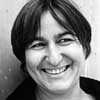
image from architects
Lacaton & Vassal
Une exposition produite par la Cité de l’architecture & du patrimoine / Institut français d’architecture, et conçue par l’agence Lacaton & Vassal
Cité de l’architecture & du patrimoine
François de Mazières, président de la Cité Francis Rambert, directeur de l’Institut français d’architecture (Ifa)
Commissariat
Anne Lacaton et Jean-Philippe Vassal, avec Patrice Goulet et Hervé Bagot
Scénographie
Anne Lacaton et Jean-Philippe Vassal, avec Emmanuelle Delage
Production et coordination générale
Emmanuelle Delage avec Julien Sage-Thomas (agence Lacaton & Vassal) Myriam Feuchot et Marion Zirk, service production (Ifa)
Dispositif audiovisuel
Artistic Vidéo
Régie
Eric Michaux et Jonathan Deledicq, service Production (Ifa)
Textes
Anne Lacaton et Jean-Philippe Vassal, avec Patrice Goulet et Cyrille Poy
Montage des diaporamas
Bruno Flament
Conception graphique de l’exposition
Serge Barto
Mise au point graphique des dessins de l’exposition
Florian De Pous, David Duchein, Frédéric Hérard, Julien Callot, Miho Nagashima
Conception et mise au point graphique des visuels de l’exposition
Cédric Rossoni, Nicolas Guerin, David Pradel, Julien Sage-Thomas, Lucinda Groueff
Reportages photographiques
Philippe Ruault, David Pradel
Coordination audiovisuelle
Jean-Christophe Levet
Recherche documentaire
Lucinda Groueff
Autres ressources documentaires
• « Palais de Tokyo 2000-2001 », réalisation David Cascaro, 2003
• « Avec vue sur Loire », réalisation de Nelly Richardeau et Sophie Averty, production les Films du funambule
• Rushes inclus dans les diaporamas « maison à Bordeaux », « Maison Cotlenko », « Bureaux à Nantes », « Maison au Cap-Ferret », réalisation Pierre-Marie Goulet, images Bruno Flament, production déléguée Aum, production Cité, 2007
Communication et partenariats
Jean-Marie Guinebert, directeur de la communication et des partenariats (Cité) Guillaume Lebigre et Claire Le Roy, conception graphique (Cité) Agostina Pinon, relations presse (Cité), assistée de IPC / Dominique du Jonchay
Systèmes d’information
Luc Lièvre, directeur des systèmes d’information (Cité), Michel Pinto et Jérôme Richard
Mécénat
Guillaume de la Broïse, directeur du développement et du mécénat (Cité) L’exposition a bénéficié du soutien de la société Technal et du partenariat média d’Arte, Beaux-Arts magazine, France Culture, Maison Française, Le Nouvel Observateur et 20 minutes
Anne Lacaton et Jean-Philippe Vassal remercient l’ensemble de leurs collaborateurs.
Anne Lacaton et Jean-Philippe Vassal ont reçu le Grand Prix national de l’architecture en 2008.
Autour de l’exposition
Entretien de Chaillot – Lacaton & Vassal
Lundi 8 décembre 2008 à 19h – Auditorium de la Cité
7 avenue Albert de Mun – Paris 16e / Entrée libre dans la limite des places disponibles
www.citechaillot.fr
Lacaton + Vassal : French Architect
Buildings / photos for the Lacaton + Vassal Architecture page welcome
Website: www.lacatonvassal.com

